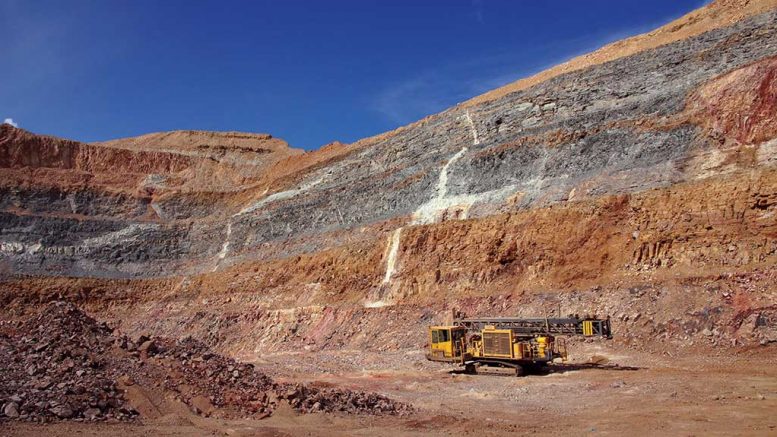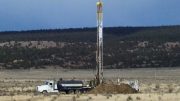U.S. firms have been atop the industry pursuing precious metals across the globe. The Northern Miner presents its top-10 list of U.S.-based, mid-tier and junior precious metals companies by market cap as of mid-July.
1. Coeur Mining
Market cap: US$1.44 billion

Surveyors at Coeur Mining’s Rochester gold-silver mine in Nevada. Credit: Coeur Mining.
Coeur Mining (NYSE: CDE) is a U.S.-based producer of precious metals with five wholly owned operating mines in the U.S. (Rochester in northwestern Nevada, Kensington in Alaska north of Juneau, and Wharf in the Black Hills mining district of South Dakota); Canada (Silvertip in northern British Columbia); and northern Mexico (Chihuahua mine). Founded in 1928 and headquartered in Chicago, its operations produce gold and or silver doré, and gold, zinc and lead concentrate.
In 2019, its open-pit Rochester mine produced 3.8 million oz. silver and 35,000 oz. gold, while its underground Kensington mine produced 128,000 oz. gold and its open-pit Wharf mine churned out 84,000 gold ounces. Its underground Silvertip mine in B.C. produced 1.2 million oz. silver, 17.1 million lb. zinc and 16.6 million lb. lead, and the Palmarejo underground mine in Mexico produced 112,000 oz. gold and 6.8 million oz. silver.
The company also has exploration projects elsewhere in North America and Mexico, including the Walker Lane trend in Nevada (the Sterling gold project) and in Mexico’s Durango state (the La Preciosa silver-gold project). The La Preciosa project is situated on the eastern flank of the Sierra Madre Occidental mountain range, 85 km northeast of the city of Durango, and is envisioned as an open-pit silver-gold mine. The Sterling project, 185 km north of Las Vegas, consists of four, high-grade, heap-leachable deposits with total inferred resources of 709,000 oz. gold.
In addition, Coeur has strategic investments in early-stage precious metals companies.
2. Argonaut Gold
Market cap: US$418 million

Argonaut Gold’s El Castillo gold mine in Mexico. Credit: Argonaut Gold.
Headquartered in Reno, Nev., Argonaut Gold (TSX: AR) completed an at-market merger with Alio Gold on July 1 creating a North American diversified intermediate producer.
The company’s principal assets are the El Castillo and San Agustin open-pit gold and silver mines, which together form the El Castillo complex in Durango, Mexico; the La Colorada open-pit gold and silver mine in Sonora, Mexico, and the Florida Canyon open-pit, heap leach gold mine in Nevada.
Last year, Argonaut produced a record 186,615 oz. gold-equivalent, a 13% year-on-year increase. Production fell short of its annual guidance of 200,000 oz. gold-equivalent, but over the last three years the company has grown production by 53%, Argonaut Gold stated in its 2019 annual report.
Its advanced exploration projects include the Magino open-pit gold project in Ontario, Canada; the Cerro del Gallo open-pit, heap leach gold-silver-copper project in Guanajuato, Mexico; and the Ana Paula open-pit gold project in Guerrero, Mexico. It also holds the San Antonio open-pit, heap leach project in Baja California Sur, Mexico.
Earlier this month, the company announced a $110 million bought deal financing with a syndicate of underwriters, including BMO Capital Markets, priced at $2.55 per share. The proceeds will be used mainly to advance the company’s Magino project.
3. Gold Resource
Market cap: US$289 million
Gold Resource’s (NYSE-AM: GORO) principal assets are in Mexico and the United States.
In Mexico’s state of Oaxaca, it owns the Arista and Mirador underground gold mines and the Aguila mill. The Arista mine started commercial production in July 2010 and consists of high-grade gold and silver mineralization, as well as copper, lead and zinc. Mineralized material is trucked 2 km from Arista to the Aguila mill. The Mirador mine started production in 2017.
In the U.S., the company’s Isabella Pearl mine in Nevada’s Walker Lane produced first gold in April 2019, just ten months after construction began.
On the exploration front, Gold Resource is targeting extensions of its deposits in Mexico and its 560 sq. km land position in the country. The company estimates that, so far, discoveries in Oaxaca represent only about 2% of its land package. It is also exploring in Nevada, where it owns 27,600 acres in Nevada’s Walker Lane mineral belt.
On July 1, the Colorado Springs’ headquartered company marked a decade of production in Mexico, which it says has generated over US$1 billion in revenue and US$114 million in total dividends, or about 10% of revenues, since July 2010. The company also offers its shareholders the option to convert their cash dividends into physical gold and silver and take delivery.
Last year, Gold Resource produced a total of 40,318 oz. gold and 1.73 million oz. silver and achieved its ninth year of profits, posting net income of US$5.8 million.
4. Gold Reserve
Market cap: US$181 million
Gold Reserve (TSXV: GRZ; US-OTC: GDRZF) owns 45% of the Siembra Minera gold-copper-silver project in the Km 88 gold-mining district of Venezuela’s Bolivar state. (The Venezuelan government owns a 55% interest.) Since 2016, the company has completed preliminary design and engineering work on a small-scale Phase 1 oxide saprolite process plant and the Phase 2 larger hard rock process plant. It has also sent saprolite samples to the U.S. for metallurgical testing and completed a preliminary economic assessment (PEA) in 2018.
In addition, the company is working on collecting payments under a settlement agreement for its Brisas gold and copper project, also in Venezuela’s Km 88 district. In 1992, the company began developing Brisas, and invested close to US$300 million in the project. But in April 2008, the government revoked previous authorization to proceed with construction, and in 2009, the company sent the case to international arbitration. In June 2017, the company signed a settlement agreement with Venezuela, under which the government agreed to pay the company US$1.03 billion. As of March 2019, the company had received US$276 million from the settlement, leaving US$756 million outstanding.
5. Gold X Mining
Market cap: US$104 million

A driller at Sandspring Resources’ Toroparu gold project in Guyana. Credit: Sandspring Resources.
Gold X Mining (TSXV: GLDX; US-OTC: SSPXF), which changed its name from Sandspring Resources in November 2019, owns the Toroparu gold project in the Upper Puruni region of western Guyana.
A preliminary economic assessment (PEA) in June 2019, which included the addition of the Sona Hill satellite deposit to the mine plan, estimates production of 4.5 million oz. gold with 125 million lb. copper by-product and 4.46 million oz. silver over a 24-year mine life. The mine plan envisions parallel carbon-in-leach (CIL) and flotation circuits that will process ore types containing varying amounts of copper. About 80% of the gold, or 3.6 million oz., will be produced as dore bars and transported off-site by air to refiners in Canada or Europe, and the remaining 20% contained in copper concentrates will be shipped in containers to smelters in Europe or Asia.
The early-stage study outlined two production phases beginning with a 4.2 million tonne per year CIL circuit operating for ten years and then expanding to 8.4 million tonnes per year with a parallel flotation circuit added to the mill in year eleven. Pre-production capex is pegged at US$378 million, which could be paid off in just under three years. At a gold price of US$1,300 per oz., the PEA forecasts cash flow from operations of US$2.54 billion. Toroparu contains 7.35 million oz. gold in the measured and indicated category and another 3.15 million oz. gold in the inferred category.
Robert Friedland, the founder of Ivanhoe Mines, joined Gold X Mining as non-executive chairman in June.
6. Fiore Gold
Market cap: US$103 million

A haul truck placing ore on the leach pad at Fiore Gold’s Pan gold mine in Nevada. Credit: Fiore Gold.
Fiore Gold (TSXV: F; US-OTC: FIOGF) owns the Pan open-pit heap leach mine in White Pine County near Eureka, Nev., and the Gold Rock exploration project, a 500 sq. km land package on the Battle Mountain-Eureka trend, 13 km southeast of Pan. The company also controls the Golden Eagle exploration project in the state of Washington, 16 km from Kinross Gold’s 1,800-tonne-per day Kettle River mill.
The Pan mine produced 41,491 oz. gold in 2019, a 21% year-on-year increase.
In April, Fiore completed a PEA on the federally permitted Gold Rock project, which envisions the project as a satellite open pit operation sharing infrastructure with the Pan mine. The early-stage study estimates a mine life of six and a half years producing 362,750 oz. gold, or an annual average of 55,800 ounces. The PEA estimates life-of-mine cash costs of US$903 per oz. and all-in sustaining costs (AISCs) of US$1,008 per ounce. Pre-production capex is pegged at US$65 million.
The company updated the resource for its Golden Eagle project in May, outlining measured and indicated resources of 52.39 million tonnes grading 1.25 grams gold per tonne and 5.99 grams silver per tonne for 2.11 million contained oz. gold and 10.08 million oz. silver. Inferred resources add 6.78 million tonnes grading 0.79 gram gold and 4.06 grams silver for 172,500 oz. gold and 885,930 oz. silver at a 0.48 gram cut-off grade.
7. Vista Gold
Market cap: US$88 million

Vista Gold Corp.’s Mt Todd gold project in Australia’s Northern Territory. Photo credit: Vista Gold Corp.
Vista Gold (TSX: VGZ; NYSE: VGZ) wholly owns the Mt Todd gold project in Australia’s Northern Territory, 290 km southeast of Darwin.
The Colorado-based company describes Mt Todd as the largest known undeveloped gold project in the country and updated its prefeasibility study in October 2019.
The study envisions a 50,000 tonne-per-day open-pit mine producing an average of 413,000 oz. gold a year over a 13-year mine life. Initial capex is estimated at US$826 million which could be repaid in just under three years. The study estimates an after-tax net present value at a 5% discount rate of US$823 million and an internal rate of return of 23.4% at a gold price of US$1,350 per ounce. Life-of-mine average cash costs were estimated at US$645 per oz., with all-in sustaining costs of US$746 per ounce.
Mt Todd, which Vista acquired in 2006, has proven and probable reserves of 221 million tonnes grading 0.82 gram gold per tonne for 5.85 million contained oz. gold. The reserves were reported using a 0.40 gram gold cut-off grade.
Vista Gold says the project also has exploration potential across its contiguous 1,100 sq. km exploration license, where it has five early-stage targets.
8. Golden Minerals
Market cap: US$60 million

A portal at Golden Minerals’ past-producing Velardena silver-gold mine in Mexico’s Durango state. Credit: Golden Minerals.
Golden Minerals (TSX: AUMN; NYSE: AUMN) has assets in Mexico, Argentina and Nevada and is primarily focused on its Velardena project in Mexico and the El Quevar property in Argentina’s Salta province. In April, Barrick Gold signed an option agreement to earn a 70% stake in El Quevar. Barrick must spend US$10 million on exploration and deliver a prefeasibility study with a mineral resource of no less than 2 million oz. gold-equivalent.
The Velardena project in Durango state has two former underground mines and two mills. (One of the mills has been leased to Hecla since 2015.) An updated PEA in April outlines a mine life of ten years with life-of-mine contained silver production of 12.3 million oz. and 188,000 oz. gold. The PEA incorporates a bio-oxidation treatment of gold concentrates. Pre-production capex is pegged at US$10.3 million.
Eighty km west of Velardena is the company’s Rodeo project. A PEA completed in April envisions an open pit mine producing 41,000 oz. gold and 118,000 oz. silver over a mine life of nine quarters. The company hopes to bring Rodeo into production in 2021 and will transport mineralized material to its oxide mill at Velardena. Pre-production costs are estimated at US$1.5 million.
Golden Minerals also owns the Santa Maria project in southern Chihuahua state, which it has optioned to Fabled Copper (TSXV: FCO). It also has the option to purchase six concessions at the Yoquivo gold-silver project, also in Chihuahua. The property is 32 km south of Agnico Eagle’s Pinos Altos mine.
The company is also earning a 60% stake in the Sand Canyon project, 80 km northwest of Winnemucca. The project is also 29 km from the Sleeper mine, which was operated by Amax Gold and produced 1.7 million oz. gold and 2.3 million oz. silver between 1986 and 1996.
9. Tristar Gold
Market cap: US$54 million
Tristar Gold’s (TSXV: TSG; US-OTC: TSGZF) flagship gold project is Castelo de Sonhos in Brazil’s Para state. The company recently completed an US$8 million finance with Royal Gold and the proceeds will be used to complete a feasibility study this year.
Castelo de Sonhos is a paleoplacer gold deposit, with 19 km of conglomerate outcrop, and only about 60% of the prospective areas has been drilled so far. The deposit remains open along strike and down dip.
The resource has grown by a factor of seven in the last three years and now contains indicated resource of 17.7 million tonnes grading 1.2 grams gold per tonne for 700,000 contained oz. gold and another 39.8 million inferred tonnes averaging 1 gram gold for 1.3 million ounces. The resource estimate used a cut-off grade of 0.3 gram gold.
A PEA completed in November 2018 envisions an open pit with a mine life of eight years producing 130,000 oz. gold a year for life-of-mine production of 1.1 million ounces. Initial capex was pegged at US$184 million, with a payback period of just under two years.
10. Paramount Gold Nevada
Market cap: US$38 million

Paramount Gold Nevada’s Grassy Mountain gold-silver property in Oregon. Credit: Paramount Gold Nevada.
Paramount Gold Nevada (NYSE-AM: PZG) owns the Grassy Mountain gold project in eastern Oregon, 113 km west of Boise, Idaho, and the Sleeper gold project in northern Nevada, 40 km northwest of the town of Winnemucca.
The company acquired Grassy Mountain in 2016 and completed a prefeasibility study in 2018 that outlines annual production of 47,000 oz. gold and 50,000 oz. silver over a 7.25-year mine life, at cash-operating costs of US$528 per oz. gold. The early-stage study estimates initial capex of US$110 million for a 750-tonne-per-day mine and milling operation, and a 2.5-year payback period. The study anticipates a US$87.7-million, after-tax net present value — at a 5% discount rate — and a 28% after-tax internal rate of return.
In June 2019, the company launched a feasibility study, which it expects to complete in mid-2020, and says it plans to start construction as soon as it receives all of the required permits, which it forecasts will be before the end of this year. In July, the company announced that the Oregon Water Resource Department had reviewed and approved its plans and specifications for the tailings dam proposed for Grassy Mountain.
Paramount’s Sleeper gold project includes the former Sleeper mine, which produced 1.7 million oz. gold and 2.3 million oz. silver. The company completed a PEA of Sleeper in 2015 that proposed a 30,000-tonne-per-day, heap-leach-only operation, with a low strip ratio and 3.5-year payback period of US$175 million in initial capital expenses. The PEA envisions annual production of 102,000 oz. gold and 105,000 oz. silver at cash-operating costs of US$529 per oz. gold-equivalent produced.
In April 2019, Paramount closed a 2% net smelter return royalty agreement for US$2 million with Franco-Nevada. The proceeds will help advance permitting efforts and the feasibility study on Grassy Mountain.





Be the first to comment on "Top 10 US-based mid-tier and junior precious metals companies"